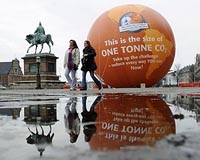| . |  |
. |
London, UK (SPX) Jun 02, 2010 Climate change is about more than just polar bears. That is the message from Dr Kate Manzo whose research into climate change communication has been published in Meteorological Applications. The research, which reviews the efforts of journalists, campaigners and politicians to engage the British public with climate change, explores how new 'visual strategies' can communicate climate change messages against a backdrop of increased climate scepticism. "There have been various efforts to put a face on the climate change issue," said Dr Manzo, from Newcastle University. "Communicators need to move away from the traditional images of polar bears or fear-laden imagery to find new, inspirational motifs to engage people with climate change. My research has uncovered a variety of possibilities - such as windmills as icons of renewable energy - as well as alternatives to documentary photography as the dominant form of climate change communication. Artists and cartoonists are among the producers of inspirational alternatives." "A recent study of American public perception showed that fewer people are convinced of the reality of climate change, and of those that are only 36% attribute it to human activity. This shows the variance of levels of climate change knowledge and understanding, which effects how people behave in response. It also highlights the need for strategies to boost the cognitive and behavioural elements of climate change engagement without resorting to methods such as fear appeals that are, at best, a double edged sword." In her study Manzo analysed the traditional standard bearing symbols of climate change, especially polar bears, which (like the images of the global poor that sometimes appear in relation to climate change) are traditionally cast as being 'helpless' and 'stranded' victims as their habitat changes around them. The most famous example of a polar bear gaining iconic status is Knut, the cub from Berlin Zoo whose image was used so successfully for political and commercial campaigns that he became the biggest cash grossing animal of all time. "Polar bears score highly in the so called identifiable victim stakes. Findings suggest that the image of a lone polar bear, like Knut, wins hands down in the affective stakes provoking feelings of pity and concern as well as charitable giving." But is it time for those communicating climate change messages to find a new motif? To answer this question Manzo studied recent charity campaigns, climate change photography and the framing of climate change articles in the press. Dr Manzo suggests that icons of extreme weather and renewable energy are the standard alternatives to faces of climate change, with images such as windmills providing an inspirational approach to a climate change message which is inherently difficult to visualise. "Visually pleasing images have indirect value when they allow organisations that use them to raise money for climate action and science. Icons of renewable energy, such as windmills, change the frame of reference from either business as usual or visions of apocalypse to possible strategies of mitigation." "All of these alternatives represent efforts to move beyond polar bears as the iconic representation of climate change and the visual sign of the so called 'age of the melt,'" concludes Manzo. "The challenge is to use visuals creatively in ways that can address all three aspects of climate change communication, i.e. cognition, affect and behaviour, without enhancing a sense of fatalism and disengagement."
Share This Article With Planet Earth
Related Links Wiley-Blackwell Climate Science News - Modeling, Mitigation Adaptation
 U.N. hopes for fresh climate start in Bonn
U.N. hopes for fresh climate start in BonnBonn, Germany (UPI) Jun 1, 2010 A fresh round of climate negotiations are under way in Germany with delegates from more than 180 governments trying to reinvigorate the deadlocked U.N. process. "Governments have repeatedly said they want progress, and now they have to show it," the United Nations' top climate official, Yvo de Boer, who is leaving his post July 1, said during a news conference Monday in Bonn. Neg ... read more |
|
| The content herein, unless otherwise known to be public domain, are Copyright 1995-2010 - SpaceDaily. AFP and UPI Wire Stories are copyright Agence France-Presse and United Press International. ESA Portal Reports are copyright European Space Agency. All NASA sourced material is public domain. Additional copyrights may apply in whole or part to other bona fide parties. Advertising does not imply endorsement,agreement or approval of any opinions, statements or information provided by SpaceDaily on any Web page published or hosted by SpaceDaily. Privacy Statement |